The Cornell Lab Bird Academy › Discussion Groups › Nature Journaling and Field Sketching › Jump Right in!
-

-
 From photo, I could see different textures of feathers, and also get general geometric shape of subject fairly quickly. This is a technique issue, but it was hard to get fine details of shading rendered with watercolors. I'd use colored pencils in the future. Photo allowed me to get shape of eyes, legs, and beak fairly accurately, which might be difficult from live observation.
From photo, I could see different textures of feathers, and also get general geometric shape of subject fairly quickly. This is a technique issue, but it was hard to get fine details of shading rendered with watercolors. I'd use colored pencils in the future. Photo allowed me to get shape of eyes, legs, and beak fairly accurately, which might be difficult from live observation. -
Drawing from a photo made me feel a little more secure as the bird was not moving. I did not feel stressed for time. What I noticed by drawing from the photo were the black stripes on the wings and tail and the red striations on the front of the bird, also the talons on the branch.

-
 1. The image was stationary in the photo and therefore I could take my time and observe the whole scene properly. I could only describe the colour in the drawing which was captured realistically in the photo.
2. I would not have noticed the lichen and moss on the branches and the reddish/brown streaks on the bird's chest. The extra bird detail could help with the final identification.
1. The image was stationary in the photo and therefore I could take my time and observe the whole scene properly. I could only describe the colour in the drawing which was captured realistically in the photo.
2. I would not have noticed the lichen and moss on the branches and the reddish/brown streaks on the bird's chest. The extra bird detail could help with the final identification. -
Drawing from the photo made it easier to concentrate on the details and colors. As for a challenge, I think seeing the bird live would help with the way the light interacts with the feathers. The photo offered detail on the texture of the feathers that I might not have noticed. The bird appeared "fluffier" than I might notice live. Yes, this could have an impact on nature journaling especially on live animals that are being drawn.
-
Advantages to photos would be quickly capturing multiple movements and actions of an animal. The advantages to drawing is the subtle movement and depth of those movements.

-
 Drawing from the photo was easy-peasy - that little guy isn't going anywhere, so I can take my time! Challenging? How to know where to stop adding detail? I could sit all day and detail the primary and secondary wing feathers, the shading of his/her neck and delicate legs and nails...
Might not have noticed the shape of the warbler's beak, sort of an "underbite", where the lower part of the beak is larger than the upper part... wouldn't have noticed how the little claws worked as they clamped around the twig... and how the feathers are tight around the head and softer and "fluffier" near the back and vent..
There's drawing from seeing and drawing from "knowing", and the first is probably going to give me the lifelike, dynamic, captured-in-motion look that I'm after, even if I think I'm seeing it wrong... the restatements help make it look like stop-action photography...
Drawing from the photo was easy-peasy - that little guy isn't going anywhere, so I can take my time! Challenging? How to know where to stop adding detail? I could sit all day and detail the primary and secondary wing feathers, the shading of his/her neck and delicate legs and nails...
Might not have noticed the shape of the warbler's beak, sort of an "underbite", where the lower part of the beak is larger than the upper part... wouldn't have noticed how the little claws worked as they clamped around the twig... and how the feathers are tight around the head and softer and "fluffier" near the back and vent..
There's drawing from seeing and drawing from "knowing", and the first is probably going to give me the lifelike, dynamic, captured-in-motion look that I'm after, even if I think I'm seeing it wrong... the restatements help make it look like stop-action photography...
-
That is such a good drawing - it is alive. It is so easy to draw something stiff from a photograph, maybe because of all the time one has to look and look again; stiff this is not.
-
-

-
Drawing from a photo, especially one in front of us felt awkward. Sure it gives you certain information that might be important for basic identification but it gives you one dimension. Drawing anything from nature is interactive. You can move around to adjust your viewpoint. I had a hard time understanding the bird's wing structure. It makes me want to study basic bird anatomy. In your sketchbook samples I loved the way the woman drawing the hummingbird looked at the bird many times and did a multitude of drawings to understand what was going on! I loved her inquisitive work. Its not "finished" per se but very self educating and personal.
-
1. Drawing from the photo was fun. The easy part was drawing the outline of the bird. The challenging part was getting the legs and bill just right . 2. I might not have noticed the black in the wings. This would make a difference when nature journaling. It would help me learn the field marks that separate a yellow warbler from all the other small yellow birds out there.

-
Most challenging for me is being patient enough to take the time to see how proportions and designs relate to one another and relay them accurately. I didn’t quite capture the either the fullness of the bird or the angle of its head. I was struck by the strength and shape of its claws. I am always fascinated by how lightly yet how stable they are as they perch on a branch.

-
I thought the overall structure wasn't too challenging, however the more I drew the photo, I noticed minor things that I didn't see before. For example, I didn't see that the feathers on the breast were brown in the beginning, I thought they were black since the wings had black lines. I think when I go nature journaling, I need to be patient and try to notice the details so that I can try to tell the difference from other species.

-
1. What advantages do photos have over drawings? Observation. A photo is a snapshot, but a sketch requires looking at the subject, its surroundings, and then capturing the energy of the scene on paper. 2. How did you feel about drawing from the photo? What came easily and what was challenging? Honestly, it was hard as I do not have an art background and have only just started drawing in the last six months. This was literally the second bird that I've ever attempted to draw. The part that is becoming a bit easier is seeing value in the subjects that I sketch. 3. Was there anything in the photo that you might not have noticed if you weren’t asked to draw it? Would this make a difference when nature journaling? Yes, the lighter values around the eyes, and various patches on the head and body. These variations in color patterns could be important to identification of the critter you are observing. 4. Why are you taking this course? What do you hope to get out of it? I am taking the course as I want to learn to see better. I love natural history and am an avid hiker / backpacker, my long term goal is to do outdoor travel writing and help people better understand the role that humans have in nature and help them reconnect with it. I am also taking this class to overcome my fear of drawing in public and letting others see my work. In truth, I wasn't going to do this post, but my goal is to get over my fear no matter what one step at a time.

-
Thanks for noting what colours you used.
-
-

-
 This was fun. I did the sketch quickly. The most difficult part to me were the lichens. I didn't get the look I wanted for them. It will be interesting to see what this looks like at the end of the course. Drawing did cause me to look at the details more closely. I think the advantage of a photograph is that you can catch your subject before it moves or flies away. The advantage of drawing is that you notice the fine details.
This was fun. I did the sketch quickly. The most difficult part to me were the lichens. I didn't get the look I wanted for them. It will be interesting to see what this looks like at the end of the course. Drawing did cause me to look at the details more closely. I think the advantage of a photograph is that you can catch your subject before it moves or flies away. The advantage of drawing is that you notice the fine details.
-

-
 1. Drawing from a photo has the advantage of being able to look back at it over and over again, while a live subject won't be still for that long. Most of my best bird sightings are fleeting at best, from a distance, and sometimes back lit. It is challenging to place the first lines from a photo that is a complete image, while a drawing is only just begun.I also really wanted it to be in color, but a pencil was all I had at hand. I'll likely go back and add color later.
2. I noticed the lichen and moss (?) on the twigs, and the insect damage on some of the leaves. I also noticed the different parts of the wing once I started to add shading and lines to the overall shape. This would be a great advantage in nature journaling to pick up on otherwise overlooked details.
1. Drawing from a photo has the advantage of being able to look back at it over and over again, while a live subject won't be still for that long. Most of my best bird sightings are fleeting at best, from a distance, and sometimes back lit. It is challenging to place the first lines from a photo that is a complete image, while a drawing is only just begun.I also really wanted it to be in color, but a pencil was all I had at hand. I'll likely go back and add color later.
2. I noticed the lichen and moss (?) on the twigs, and the insect damage on some of the leaves. I also noticed the different parts of the wing once I started to add shading and lines to the overall shape. This would be a great advantage in nature journaling to pick up on otherwise overlooked details. -
 I liked drawing from a photo. There was no pressure and no hurry. The challenge was to be able to create a 3d effect. I need to further develop the skills required to manipulate light and dark better. The background in the photo was totally washed out. I think drawing live would have allowed me to add more details about the environment, eg. weather, time of day, season, maybe other plants or creatures, making a more complete picture.
I liked drawing from a photo. There was no pressure and no hurry. The challenge was to be able to create a 3d effect. I need to further develop the skills required to manipulate light and dark better. The background in the photo was totally washed out. I think drawing live would have allowed me to add more details about the environment, eg. weather, time of day, season, maybe other plants or creatures, making a more complete picture. -

-
I can see you were able to capture the bird's head turned slightly. It was not until I started drawing that I noticed that, and found it hard to do.
-
-
I was glad to start with a still object as a photo. This was my very first bird ever to draw! So I really had to think out of my normal site to view a photo. I tried to measure in my mind distances in order to get perspective. How do you draw feathers? Wow that one baffled me. Also to relay softness in the body didn't work. How do you draw softness? Yellow legs was something I would have missed if not drawn.

-
Great sketch for a first time bird. I also liked your observations / notes.
-
-
Drawing the photo was not easy for me. I worried about getting the proportions and shapes right and it was challenging to get the positioning of the feet right. Good thing I could use an eraser! I had difficulty getting the bird’s tail to arch up. My second attempt was slightly better in capturing the bird’s stance. Because I was drawing the bird I paid more attention to reddish brown streaks on the warbler’s breast and the contrasting colors of its feathers. I think learning to be more aware of the details and variations in coloration will make a difference when nature journaling. Also I am learning to have a greater appreciation of how birds stand and move.

-

-
It’s challenging to get the right proportions for the head and body, and the correct angles, but I look forward to developing those skills so I can sketch birds more accurately and quickly. I loved exploring the feather groups and how they overlap. Feathers almost look furry. And bird feet are crazy interesting - such long toes. I wouldn’t have noticed the subtle colors and feather groups if I hadn’t try to draw it.

-
I always find birds challenging. Even though they are made up of simple geometric shapes, they are tricky! I started by trying to identify simple shapes, and then I went back in with pen and did a more true outline of the bird with minimal texture for the different feathers. Sketching initial shapes was challenging, and going back in afterwards felt easier. So maybe sketching the shapes first was helpful...? If I hadn't been asked to draw this bird and had just seen it, or perhaps taken a photo, I might not have noticed the beautiful little branch it was on. I just loved the different colors and varieties of lichen on that branch! Natural journaling certainly helps you take in general impressions of things as well as the tiny details.

-
I like drawing from a photo. The correct shape of the bird, it’s beak, and feather details were most challenging. The very small details in the different feathers and the branch I
 only noticed when trying to draw them. The details are what makes the image so beautiful.
only noticed when trying to draw them. The details are what makes the image so beautiful.
Read More:

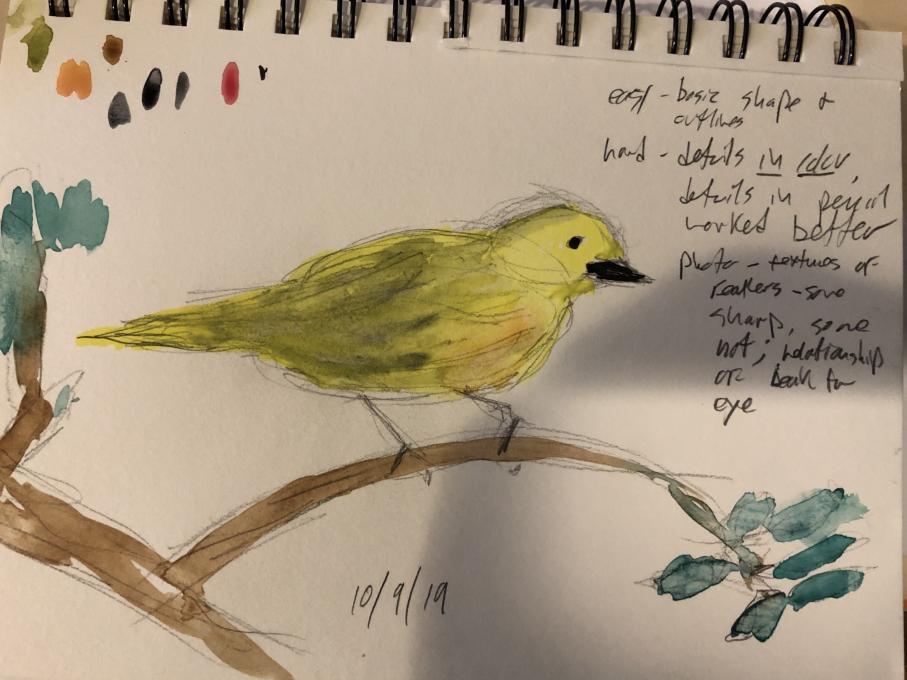 From photo, I could see different textures of feathers, and also get general geometric shape of subject fairly quickly. This is a technique issue, but it was hard to get fine details of shading rendered with watercolors. I'd use colored pencils in the future. Photo allowed me to get shape of eyes, legs, and beak fairly accurately, which might be difficult from live observation.
From photo, I could see different textures of feathers, and also get general geometric shape of subject fairly quickly. This is a technique issue, but it was hard to get fine details of shading rendered with watercolors. I'd use colored pencils in the future. Photo allowed me to get shape of eyes, legs, and beak fairly accurately, which might be difficult from live observation. 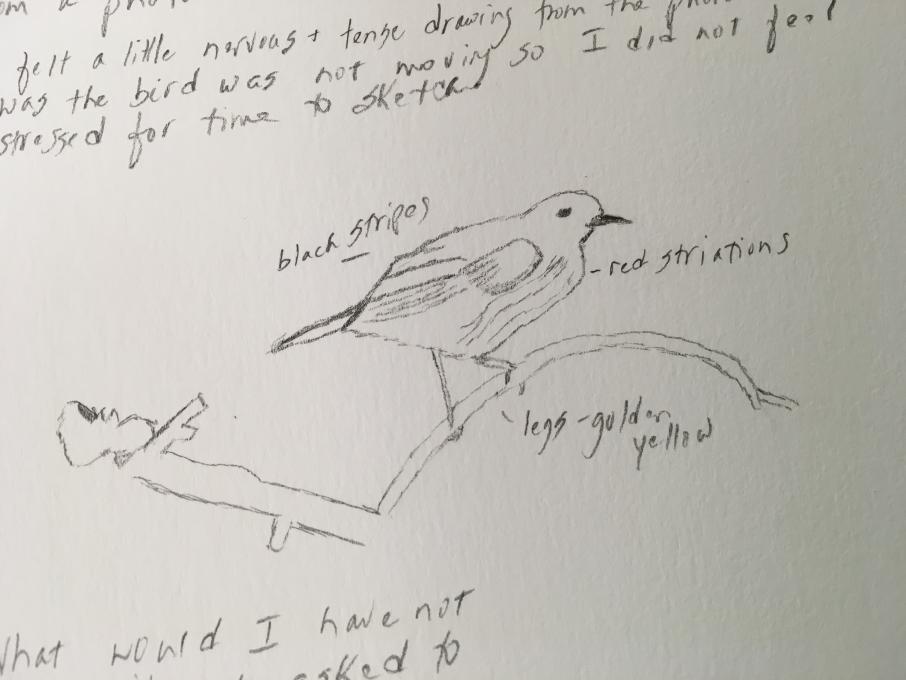
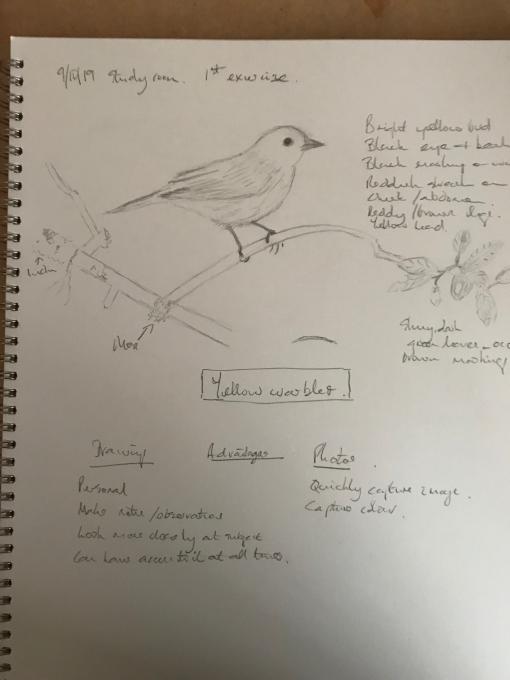 1. The image was stationary in the photo and therefore I could take my time and observe the whole scene properly. I could only describe the colour in the drawing which was captured realistically in the photo.
2. I would not have noticed the lichen and moss on the branches and the reddish/brown streaks on the bird's chest. The extra bird detail could help with the final identification.
1. The image was stationary in the photo and therefore I could take my time and observe the whole scene properly. I could only describe the colour in the drawing which was captured realistically in the photo.
2. I would not have noticed the lichen and moss on the branches and the reddish/brown streaks on the bird's chest. The extra bird detail could help with the final identification. 
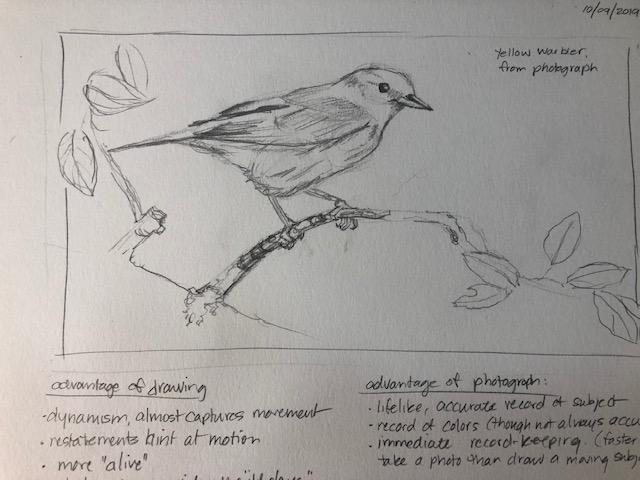 Drawing from the photo was easy-peasy - that little guy isn't going anywhere, so I can take my time! Challenging? How to know where to stop adding detail? I could sit all day and detail the primary and secondary wing feathers, the shading of his/her neck and delicate legs and nails...
Might not have noticed the shape of the warbler's beak, sort of an "underbite", where the lower part of the beak is larger than the upper part... wouldn't have noticed how the little claws worked as they clamped around the twig... and how the feathers are tight around the head and softer and "fluffier" near the back and vent..
There's drawing from seeing and drawing from "knowing", and the first is probably going to give me the lifelike, dynamic, captured-in-motion look that I'm after, even if I think I'm seeing it wrong... the restatements help make it look like stop-action photography...
Drawing from the photo was easy-peasy - that little guy isn't going anywhere, so I can take my time! Challenging? How to know where to stop adding detail? I could sit all day and detail the primary and secondary wing feathers, the shading of his/her neck and delicate legs and nails...
Might not have noticed the shape of the warbler's beak, sort of an "underbite", where the lower part of the beak is larger than the upper part... wouldn't have noticed how the little claws worked as they clamped around the twig... and how the feathers are tight around the head and softer and "fluffier" near the back and vent..
There's drawing from seeing and drawing from "knowing", and the first is probably going to give me the lifelike, dynamic, captured-in-motion look that I'm after, even if I think I'm seeing it wrong... the restatements help make it look like stop-action photography...
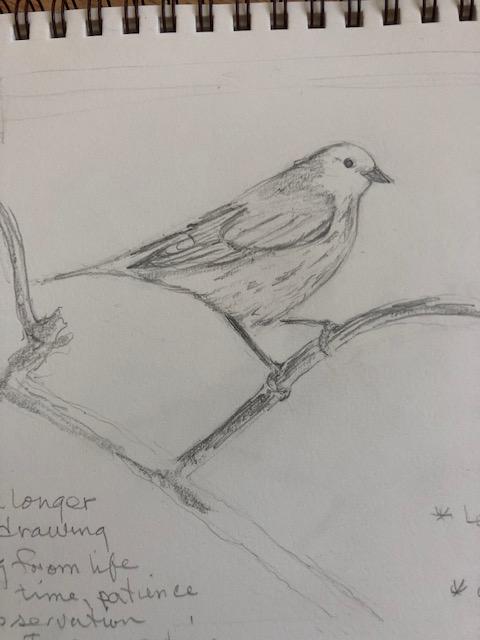
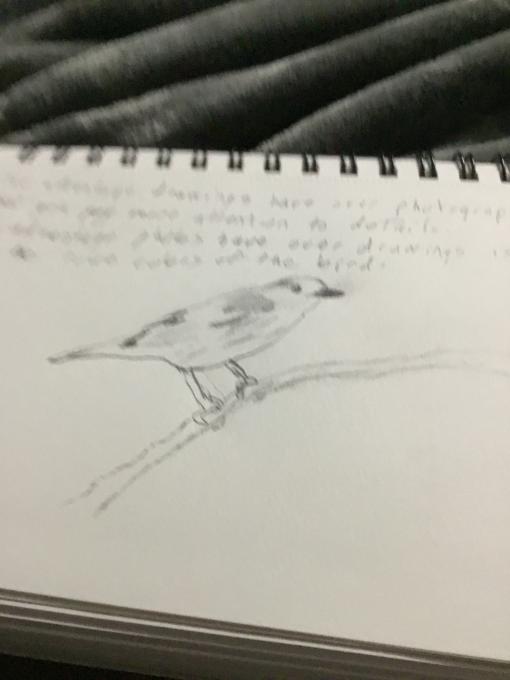

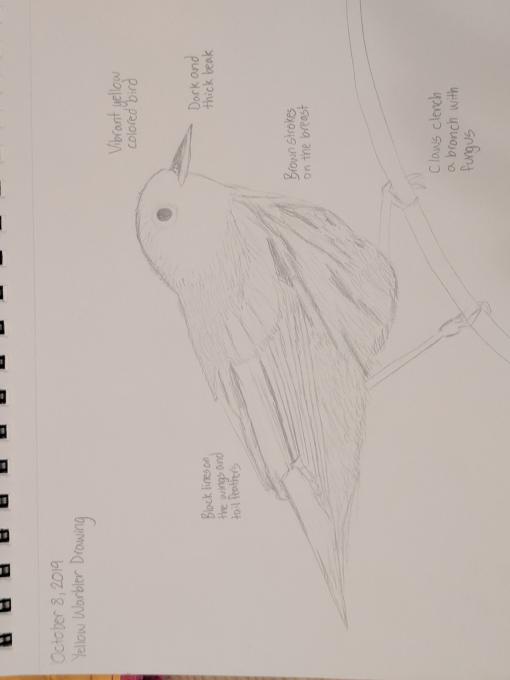


 This was fun. I did the sketch quickly. The most difficult part to me were the lichens. I didn't get the look I wanted for them. It will be interesting to see what this looks like at the end of the course. Drawing did cause me to look at the details more closely. I think the advantage of a photograph is that you can catch your subject before it moves or flies away. The advantage of drawing is that you notice the fine details.
This was fun. I did the sketch quickly. The most difficult part to me were the lichens. I didn't get the look I wanted for them. It will be interesting to see what this looks like at the end of the course. Drawing did cause me to look at the details more closely. I think the advantage of a photograph is that you can catch your subject before it moves or flies away. The advantage of drawing is that you notice the fine details.

 1. Drawing from a photo has the advantage of being able to look back at it over and over again, while a live subject won't be still for that long. Most of my best bird sightings are fleeting at best, from a distance, and sometimes back lit. It is challenging to place the first lines from a photo that is a complete image, while a drawing is only just begun.I also really wanted it to be in color, but a pencil was all I had at hand. I'll likely go back and add color later.
2. I noticed the lichen and moss (?) on the twigs, and the insect damage on some of the leaves. I also noticed the different parts of the wing once I started to add shading and lines to the overall shape. This would be a great advantage in nature journaling to pick up on otherwise overlooked details.
1. Drawing from a photo has the advantage of being able to look back at it over and over again, while a live subject won't be still for that long. Most of my best bird sightings are fleeting at best, from a distance, and sometimes back lit. It is challenging to place the first lines from a photo that is a complete image, while a drawing is only just begun.I also really wanted it to be in color, but a pencil was all I had at hand. I'll likely go back and add color later.
2. I noticed the lichen and moss (?) on the twigs, and the insect damage on some of the leaves. I also noticed the different parts of the wing once I started to add shading and lines to the overall shape. This would be a great advantage in nature journaling to pick up on otherwise overlooked details. 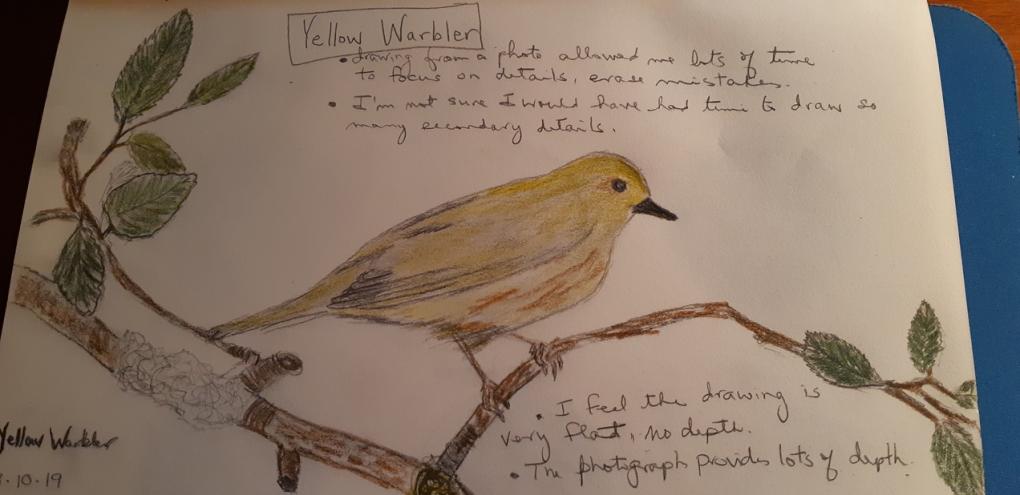 I liked drawing from a photo. There was no pressure and no hurry. The challenge was to be able to create a 3d effect. I need to further develop the skills required to manipulate light and dark better. The background in the photo was totally washed out. I think drawing live would have allowed me to add more details about the environment, eg. weather, time of day, season, maybe other plants or creatures, making a more complete picture.
I liked drawing from a photo. There was no pressure and no hurry. The challenge was to be able to create a 3d effect. I need to further develop the skills required to manipulate light and dark better. The background in the photo was totally washed out. I think drawing live would have allowed me to add more details about the environment, eg. weather, time of day, season, maybe other plants or creatures, making a more complete picture. 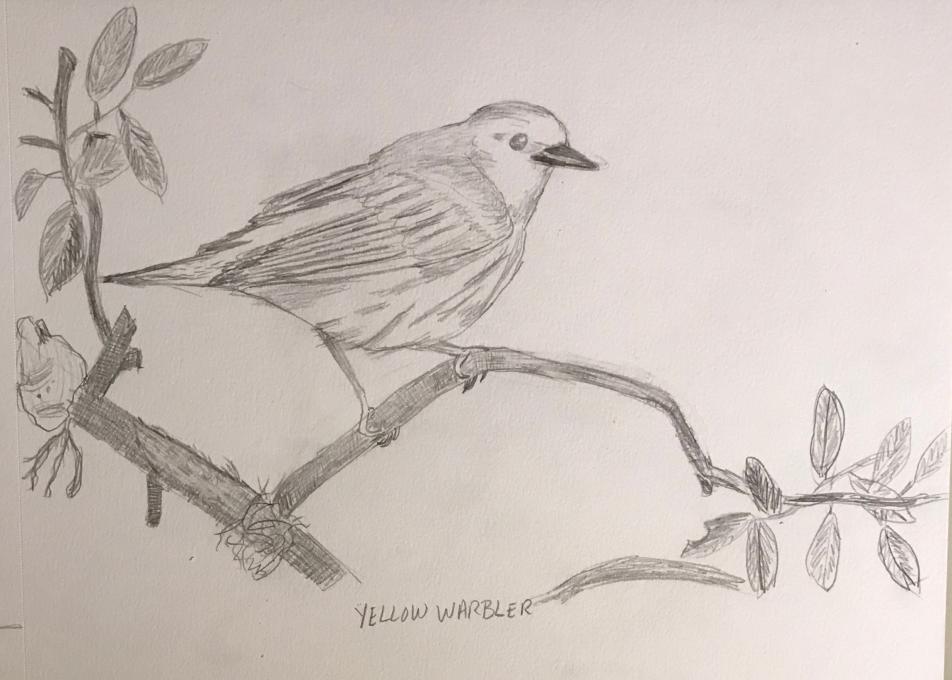

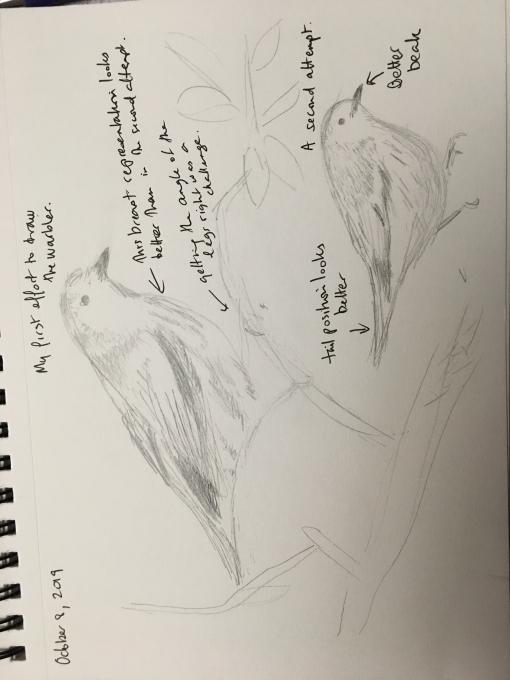


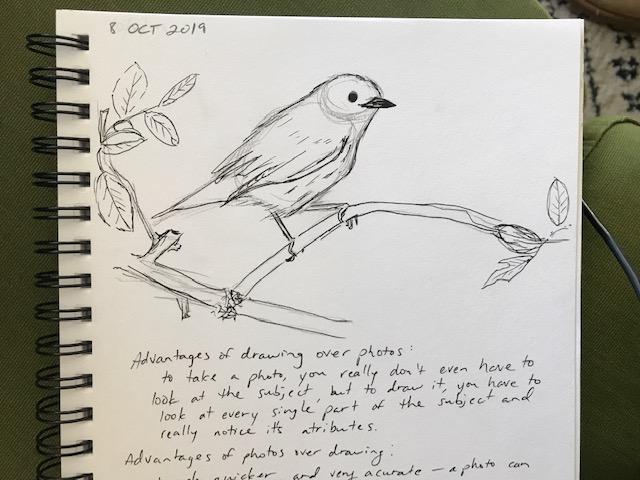
 only noticed when trying to draw them. The details are what makes the image so beautiful.
only noticed when trying to draw them. The details are what makes the image so beautiful.